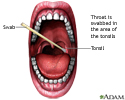Streptococcal screen
Rapid strep test
A streptococcal screen is a test to detect group A streptococcus. This bacteria is the most common cause of strep throat .
Strep throat
Strep throat is a disease that causes a sore throat (pharyngitis). It is an infection with a germ called group A streptococcus bacteria.

How the Test is Performed
The test requires a throat swab. The swab is tested to identify group A streptococcus. It takes about 7 minutes to get the results.
How to Prepare for the Test
There is no special preparation. Tell your health care provider if you are taking antibiotics, or have recently taken them.
How the Test will Feel
The back of your throat will be swabbed in the area of your tonsils. This may make you gag.
Why the Test is Performed
Your provider may recommend this test if you have signs of strep throat, which include:
- Fever
- Sore throat
- Tender and swollen glands at the front of your neck
- White or yellow spots on your tonsils
Normal Results
A negative strep screen most often means group A streptococcus is not present. It is unlikely that you have strep throat.
If your provider still thinks that you may have strep throat, a throat culture will be done.
Throat culture
A throat swab culture is a laboratory test that is done to identify germs that may cause infection in the throat. It is most often used to diagnose ...

What Abnormal Results Mean
A positive strep screen most often means group A streptococcus is present, and confirms that you have strep throat.
Sometimes, the test may be positive even if you do not have strep. This is called a false-positive result.
Risks
There are no risks.
Considerations
This test screens for the group A streptococcus bacteria only. It will not detect other causes of sore throat.
References
Flores AR, Caserta MT. Pharyngitis. In: Bennett JE, Dolin R, Blaser MJ, eds. Mandell, Douglas and Bennett's Principles and Practice of Infectious Diseases . 8th ed. Philadelphia, PA: Elsevier Saunders; 2015:chap 59.
Nussenbaum B, Bradford CR. Pharyngitis in adults. In: Flint PW, Haughey BH, Lund V, et al, eds. Cummings Otolaryngology: Head and Neck Surgery . 6th ed. Philadelphia, PA: Elsevier Saunders; 2015:chap 9.
Shulman ST. Group A streptococcus. In: Kliegman RM, Stanton BF, St Geme JW, Schor NF, eds. Nelson Textbook of Pediatrics . 20th ed. Philadelphia, PA: Elsevier; 2016:chap 183.
Weber R. Pharyngitis. In: Bope ET, Kellerman RD, eds. Conn's Current Therapy 2016 . Philadelphia, PA: Elsevier; 2016:section 1.
-
Throat anatomy - illustration
Structures of the throat include the esophagus, trachea, epiglottis and tonsils.
Throat anatomy
illustration
-
Throat swabs - illustration
A throat swab can be used to determine if Group A Streptococcus bacteria is the cause of pharyngitis in a patient.
Throat swabs
illustration
-
Throat anatomy - illustration
Structures of the throat include the esophagus, trachea, epiglottis and tonsils.
Throat anatomy
illustration
-
Throat swabs - illustration
A throat swab can be used to determine if Group A Streptococcus bacteria is the cause of pharyngitis in a patient.
Throat swabs
illustration
Review Date: 3/13/2016
Reviewed By: Jatin M. Vyas, MD, PhD, Assistant Professor in Medicine, Harvard Medical School; Assistant in Medicine, Division of Infectious Disease, Department of Medicine, Massachusetts General Hospital, Boston, MA. Also reviewed by David Zieve, MD, MHA, Isla Ogilvie, PhD, and the A.D.A.M. Editorial team.


